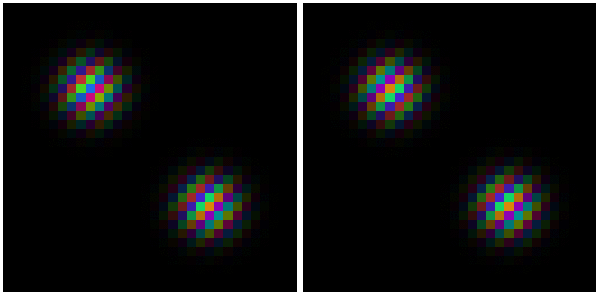Comparing the collision of two identical fermions with the collision of two identical bosons both living on a linear lattice of 32 sites, UM 2014-09-05

Left image: Model of colliding fermions. Right image: Model of colliding bosons.
What is represented is the complex-valued (color-coded) wave function of two identical particles, which are fermions in the left figure and bosons in the right one.
Both particles 'live on' a one-dimensional lattice of 32 sites. We shall refer to this lattice as the biotope (of the particles). Since there are two particles in the biotope, there is an amplitude for simultaneous triggering of two ideal detectors. The discrete position of one detector is represented as a position on the x-axis and the position of the other detector is represented as a position on the y-axis . The color of the pixel belonging to that point (x,y) represents the trigger amplitude (the squared modulus of which gives the probability of a simultaneous trigger event). The image diagonal x=y then gives an amplitude for detecting both particles at the same point of the biotope and thus should be 0 (black as a color) in the fermion case. This is in fact what the pictures show.
The dynamics is that of non-relativistic particles which do not interact with each other (i.e. there is no particle to particle interaction contribution to the Hamiltonian). There is however a strong external potential (proportional to the eight-th power of the distance from the mid of the biotope) which confines the motion of the particles to this finite biotope by reflecting them back from both ends.
The initial condition is such that the particles start as well localized and separated Gaussian wave-packets which carry opposite momenta pointing towards the center of the biotope. So they are set up to collide at this center and one could expect that the inability of two fermions to populate the same position could bring about considerable differences between the motion of fermions and bosons in our present situation. The surprising observation is that the main structure of the wave function particularly the location of its more pronounced hills is very similar in the two cases.
In both cases one could interpret the dynamics of the wave function as a motion of two particles with constant velocity or equally well as an elastic reflection of each particle from its partner particle. From Pauli's principle we would expect the first interpretation to be more appropriate for bosons and the second for fermions. The present simulation seems not to present evidence for such an interpretation. It illustrates how wave function dynamics lets the concept of particle trajectories become diffuse without making it completely useless.
Since the gif-image has a size of 15 MB it may take some time to load. If loading is complete, the animation should run smoothly.
Addition 2024-04-09
My presently available hard ware and soft ware tools allow to show (essentialy) the same system with higher resolution (128 instead of 32 lattice sites) in a more convenient image format (mp4 insterad of gif). One will probably detect in this 'high resolution'-representation features that do not clearly shine up in the original 'low resolution' version.
Left image: Model of colliding fermions. Right image: Model of colliding bosons.